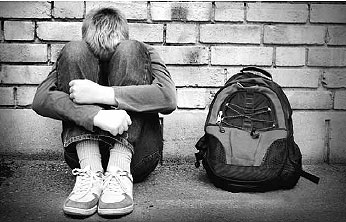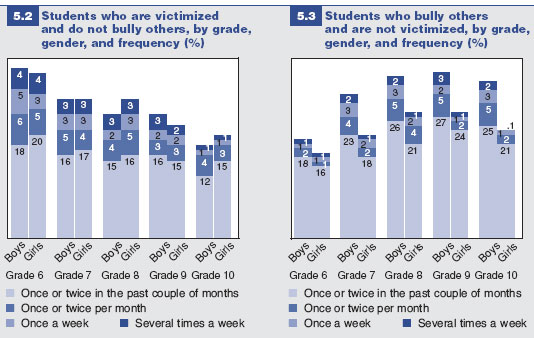Common menu bar links
Institutional links
Diseases & Conditions
Health & Safety
Research & Statistics
Agency Information
Search Box
Healthy settings for young people in Canada
Previous | Table of Contents | Next
5 Bullying and Fighting
by Wendy M. Craig and Heather McCuaig Edge
What is bullying?
 Bullying is a relationship problem. It is a form of
aggressive behaviour imposed from a position of
power. Young people who bully always have more power
than the peers they victimize. Power can be achieved
through physical, psychological, social, or systemic
advantage, or by knowing another’s vulnerability
(e.g., obesity, learning problem, sexual orientation,
family background) and using that knowledge to cause
distress. With each repeated bullying incident, the
young person who is bullying increases in power and
the young person who is being victimized loses power.
Bullying is a relationship problem. It is a form of
aggressive behaviour imposed from a position of
power. Young people who bully always have more power
than the peers they victimize. Power can be achieved
through physical, psychological, social, or systemic
advantage, or by knowing another’s vulnerability
(e.g., obesity, learning problem, sexual orientation,
family background) and using that knowledge to cause
distress. With each repeated bullying incident, the
young person who is bullying increases in power and
the young person who is being victimized loses power.
Fighting and weapon carrying
| Data on injuries due to fighting and violence are presented in Chapter 6. |
Fighting and weapon carrying are also behaviours that put young people at significant risk for harm. Fighting can often lead to physical injuries requiring medical treatment. Weapon carrying increases the possibility of more severe – even life-threatening – injuries to both the weapon carrier and others.

Why does bullying matter?
Lessons of power and aggression learned through childhood bullying can lead to sexual harassment and dating aggression and may later extend to workplace harassment, as well as marital, child, and elder abuse perpetrated by adults.1 Victimized youths may also carry the hurt and fear from bullying forward into adult relationships. Perhaps the highest costs arise from the destructive dynamics found in bullying relationships, because relationships are the foundation for healthy development and well-being throughout the lifespan. Furthermore, research on bullying has identified an intergenerational link: parents who bully in childhood are likely to have children who also bully their peers.2
Being safe in relationships is a fundamental human right. Every child and youth has the right to be safe and free from involvement in bullying. Bullying affects the safety and welfare of children and youth who are bullied, those who bully others, and those who know it is going on. Victimized young people are at risk for anxiety, depression, and somatic complaints. 3 There is also reason to be concerned for young people who perpetrate bullying and harassment: research has shown that they are at risk for long-term problems such as anti-social behaviour and substance use.4,5 To prevent these negative long-term outcomes, we need to support youths’ healthy development and protect their welfare. This requirement is identified in the United Nations Convention on the Rights of the Child.6
How are bullying, fighting, and weapon carrying measured by the HBSC study?
Types of victimization surveyed:
|
To assess bullying and victimization, students were asked how many times they had been bullied at school in the past couple of months and how often they had taken part in bullying another student(s) at school during the same time period. Possible responses were never, once or twice, 2 or 3 times a month, about once a week, or several times a week. Those who reported being bullied at least once in this time period were classified as victims of bullying. Those who reported taking part in bullying at least once in this time period were classified as bullies. Those who reported both experiences were classified as bully-victims. There were also questions about the types of victimization experienced.
To measure fighting and weapon carrying, students were asked about the number of times they were in a physical fight in the past 12 months and with whom, and the number of days in the past 30 days on which they carried a weapon, such as a gun, knife, or club, and what type of weapon it was.
What are we reporting on in this chapter?
We report on the percentage of students involved in the three categories of bullying (victims, bullies, and bully-victims) for 2002 and 2006, the patterns in kinds of victimization, the number of fights and the targets of fights, the types of weapons carried by boys and girls, and bullying in relation to the home, school, peer, and socio-economic contexts.
The size of the bullying problem in Canada
In an analysis of the HBSC data from the 2002 cycle, researchers discovered that Canada ranked a dismal 26th and 27th highest out of 35 countries in terms of proportion of young people reporting involvement in bullying and victimization respectively.7
Figure 5.1 represents the overall prevalence of Canadian students with involvement in bullying in 2002 compared to 2006. The trend is towards a very slight decrease in reported bullying involvement since the previous survey.


 Figure 5.2 presents a general decline in
reported victimization from Grade 6 to 10.
A fairly consistent proportion of students
across grades report being victimized about
once or twice in the past couple of months.
Between 2 and 9% of students report being
victimized once a week or more.
Figure 5.2 presents a general decline in
reported victimization from Grade 6 to 10.
A fairly consistent proportion of students
across grades report being victimized about
once or twice in the past couple of months.
Between 2 and 9% of students report being
victimized once a week or more.
Boys report bullying others significantly more than do girls (Figure 5.3). For boys, the behaviour peaks in Grade 9 at 37%; for girls, in Grades 8 and 9 at 28%. The majority of students indicate that they engage in bullying behaviour infrequently. A small minority (1 to 5%) of students, however, report bullying others regularly.
A substantial number of students in the HBSC sample report that they are both bullies and victims (Figure 5.4). In Grades 8 and 9, boys report involvement in both bullying and victimization more often than girls.

